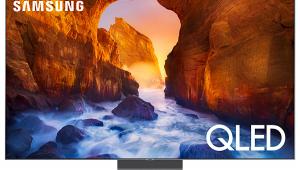I like it a lot, but I want one at least 120 inch so I can replace my projector in my theater.
Samsung 98" QN100B Neo QLED 4K TV Review
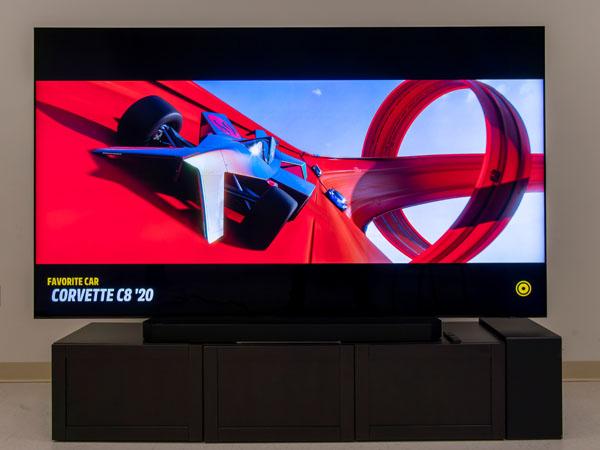
AT A GLANCE
Plus
Incredible brightness
Cutting-edge picture quality
Lays flat on wall
Minus
No Dolby Vision
Extremely expensive
THE VERDICT
A 4K tour-de-force from Samsung, the QN100B loves to show you what's missing from less capable TVs.
Samsung's over-the-top 98-inch Neo QLED showcases what's possible when a TV has the horsepower needed to handle HDR properly. What's mind-blowing is in HDR mode, its measured brightness can exceed 1000 nits, full-screen. Few TVs of any size can achieve this level of brightness, and the QN100B does it while preserving extremely high contrast and offering a wide color gamut. The resulting picture quality is thought-provoking, even at this price point, because it begs the question of what to prioritize for the ultimate home viewing experience: Size or HDR capability.
Projectors are great for size; a projector is the only economical option if you want to go beyond 100 inches. But TVs are the way to go for vivid HDR because most 4K content for home viewing is mastered in HDR to a 1000-nit standard. That is far beyond the peak luminance projectors can achieve. But now, we've got a TV that offers a screen size that used to be the exclusive domain of projectors combined with HDR performance that exceeds what you get from projectors and the vast majority of TVs.
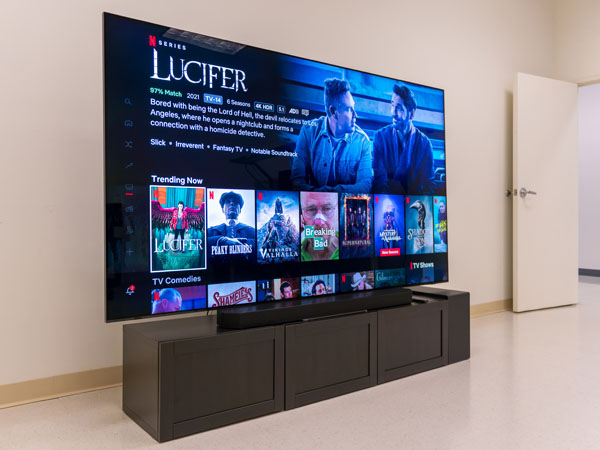
Check out the size of the TV compared to the door in the background
Features and Setup
The most obvious feature of the QN100B is the 98-inch screen, which is glossy but highly anti-reflective. The physical design is that of a pure slab; this Samsung sits flush against a wall and comes with a special mounting bracket that lets you hang it this way. The ultra-minimalist bezel has perforations on the sides for the built-in speakers; viewed from the front, the bezel is practically non-existent.

The slab-like form factor of the QN100B is visible on this side profile view.
The quantum-dot LED panel on this TV is backlit by a mini-LED array. Samsung calls this technology Neo-QLED, which offers extremely high brightness. Peak luminance levels are way beyond what OLED achieves and depending on what you are watching and the room's ambient light conditions, the brightness makes this TV stand out from anything else this size I've seen before.
Samsung's QN100B is too large, heavy, and rarefied to review in my home, so I worked with the company to get hands-on time with a sample in one of its facilities. Consequently, I had to limit my experience with the TV to a single day, but during that time, I was left alone to do what I wished with the TV. I brought my own Xbox Series X to serve as a source for the session, whether for playing an Ultra HD Blu-ray or a video game.
You connect to the QN100B using Samsung's clever One Connect box, which houses the TV's power supply, processing and HDMI switching. The box connects to the flat panel with a single cable (hence One Connect) that carries both power and the video signal. The One Connect has four HDMI inputs that support 4K/120 Hz signals.
At my request, Samsung set up the TV with a HW-Q900B 11.1.4 soundbar system, which works in conjunction with the QN100B's speakers when using the Q-Symphony function. This is a true maximalist all-Samsung home entertainment system.
Despite its low profile and slab-like form, Samsung cleverly sneaks in a sophisticated speaker system, including an array of ultra low-profile rear-facing bass drivers. You don't even notice the side-firing speakers because of how they are integrated into the perforated bezel. Samsung classifies it as a 6.4.4 system with Dolby Atmos capability, and all things considered it has very good sound for a TV, but adding the soundbar to the mix—with or without Q-Symphony—was still a huge step up in dynamics and envelopment.
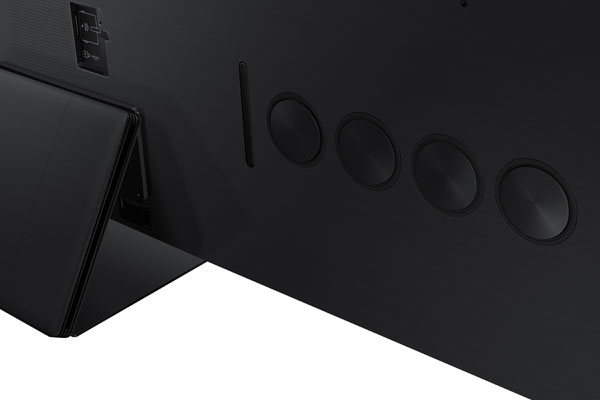
The four subwoofer drivers on the rear of the TV
The room where I performed the evaluation was a large, windowless space with light tile floors, white walls, and a ceiling with high-output in-ceiling overhead lights. The lights are super bright, like a living room with many windows on a sunny day. But with the lights out, it's totally dark, like a dedicated home theater (albeit with white walls).
The TV was not professionally calibrated; I used the factory settings. But I made adjustments to those settings as I saw fit because this TV's raw capability gives you plenty of options for how it renders an image, and I found just a few minutes of messing with the settings yielded a subjectively ideal image. What did I do? Suffice it to say there's more than one way to get there, but basically, I set the Color Tone to Warm2 (D65, 6500K), turned off all the motion interpolation processing, ensured Local Dimming was on Standard Low, turned on Contrast Enhancer and set that to Low as well (or live dangerously, set it to high, you might just like it!). I can see situations where you might also tweak the Shadow Detail setting, depending on the room lighting. You don't need a meter to do any of this stuff; the test patterns and clips on the Spears & Munsil UHD Benchmark disc are all you need to optimize a TV's picture in this manner.
One of the realities of most TVs is that the absolute brightest mode is usually not the most color accurate. But with the QN100B, you have so much spare brightness on tap; it does not matter. You can use highly color-accurate settings, and the image will still pop off the screen—even in a bright room—with vivid color and contrast.
Performance
The QN100B is a statement TV, delivering world-class performance with lights on and off. I brought my usual stack of test discs, including Harry Potter and the Deathly Hallows Part 2, Billy Lynn's Long Halftime Walk, and the Spears & Munsil UHD Benchmark. Also loaded on the Xbox One X were Grand Theft Auto Online and Forza Horizon 5 to test out gaming. The results ranged from impressive to mind-blowing.
While the TV's built-in settings are good, a few selective tweaks elevated the experience to "whoa, I've never seen it look that good before." The trick is not to be afraid of the tools Samsung supplies to enhance contrast and get the most out of HDR. Remember, most TVs are forced to tone map because they don't natively possess the power to illuminate a scene like a mastering monitor can. But this TV has this ability, and in many cases, it can go beyond that, so, for example, you can watch HDR content with the lights on, and it still looks bright and vibrant.
With Harry Potter, what I saw in the infamous "Voldemort and his army on the mountaintop" scene, was a shockingly nuanced portrayal of deep, dark shadow details. The whole scene had depth and definition that is rarely properly expressed, and certainly not by any projector I've seen. And then, moments later, as the attack commences and fireballs fly, the incredible vibrance of this TV's ultra-bright HDR highlights take over, wowing with their brilliance. I love it when a TV looks so good you can't help but gawk and marvel at it, and you get that with the QN100B.
Billy Lynn's Long Halftime Walk is notable for its 120 frames per second 3D HDR 4K cinematography. On disc that's reduced to 60 frame per second 2D 4K HDR, which looks pristine. Even if you don't like the movie, the main scene during a fictional Dallas Cowboys football game halftime show is a dazzling technical showcase. And not a bunch of CGI special effects, either. This is choreographed with practical effects, fireworks, and dancers, and throughout the whole scene, I was blown away by the next-level clarity. There's one moment where the camera does a 360-degree swooping maneuver around Billy Lynn that's rendered with a smoothness that made everyone in the room gasp.
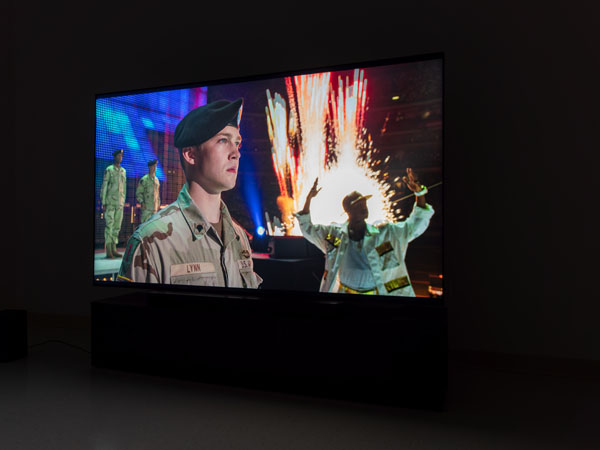
The halftime show scene is a visual spectacle, rendered impeccably by the QN100B.
Here is the thing about high frame rate, used properly; it's not about rejecting the traditional look of motion pictures and embracing the soap opera effect. What it can do for you is deliver more visible detail on screen, especially during busy action scenes with a lot of motion. But you may not appreciate that advantage if you're not watching a movie on a display that can deliver all of that detail, for example, if the TV screen is too small or if you are using a projector where the lens is simply not as sharp as the highly resolving pixel grid of a 4K flat panel display.
While very few movies are filmed in high frame rates, with video games, it's a given that's a capability you want. With the QN100B, you get support for 4K up to 120 Hz. Neither of the games I tried had a 120 Hz mode, so I could not experience that, but at 60 Hz, the games (Forza Horizon 5, GTA Online) looked ultra-detailed and played smoothly. This TV is one of the finest ways to play video games because it completely immerses you in action with its size and the quality of the picture.

I've waited my whole life to play a driving game with this quality graphics.
As usual, I played the Spears & Munsil UHD Benchmark Spicy Pixels 4K HDR demo clips for evaluating a TV. These clips serve as standard visual reference, I've seen them on hundreds of different TVs. This is the pièce de résistance; the QN100B ate up the demo scenes and turned them into vivid vignettes that—cliches notwithstanding—sometimes had the appearance of looking out a giant picture window.
The only caveat to my enthusiasm is that this is a full array local dimming, led-lit VA LCD panel, and while it's a state-of-the-art expression of what this popular type of TV can do, it shares a few weaknesses with its brethren. Like how the picture quality starts to deteriorate when you are significantly off axis. It's also possible—however rare—that you'll spot a hint of the backlight in some very tough scenes with black backgrounds; while the QN100B offers impressive contrast, an OLED still does star fields better. The key to appreciating this TV is to not let a thirst for perfection get in the way of drinking out of the fountain, just remember to sit perpendicular to the screen for the best effect.
We put a meter on the QN100B to see what sort of peak brightness it offered in its Dynamic mode and to test the accuracy of the Filmmaker and Cinema modes. The brightness measurements are an empirical affirmation of what your eyes tell you when you see this screen. It has a vibrance you are not accustomed to seeing on a TV. With a full-screen 100% white pattern, it outputs a bit over 1000 nits! Compare that to OLED—which struggles to get to 200 nits full-screen—and you can start to see what a different animal this is. With a 25% window, it can get close to 3000 nits in the Dynamic picture mode. It's at the 10% window size where it achieves its highest peak, over 6000 nits! And this TV even achieves almost 2000 nits of peak luminance with a 1% window, meaning it can do pinpoint HDR brightness, not just large areas of high brightness.
The built-in Movie mode has a lot going for it; even without a pro calibration, the color temperature measured around 6740 K, and the grayscale deltaE averaged 1.8 (under 2.0 is perceptually accurate), with gamma measuring 2.384 (the target is 2.4). Yes, a professional calibration will improve upon the numbers I just listed, but these are within the ballpark for accurate color. Also, the Movie mode offers 98.9% coverage of the DCI/P3 color space, so you are essentially getting full coverage of wide color gamut with HDR content.
The default Filmmaker mode is a little bit more dogmatic about what settings are turned off. I personally preferred the look of the Movie mode, but I also understand why a movie lover may want to use this purist-oriented setting. It endeavors to be the most faithful to creative intent, but sometimes I feel it misses out on opportunities to render HDR with a bit more gusto. Under a meter, it is even more technically accurate than Movie, with a color temperature of 6714 K and gamma measuring 2.392. Grayscale deltaE was the same, 1.8, so overall very good color with a little bit of room for improvement should an owner opt for a pro calibration.
Long story short, if you buy a $40,000 TV you should have it professionally calibrated. However, if you decide not to, the out-of-the-box performance of the QN100B is commendably accurate, and that's the performance I saw during the hands-on session.
Conclusion
This TV is what's known as aspirational gear. It is why early adopters exist, to fund technology that the rest of us can afford when it trickles down in the future. But this is no trade show concept; it's a real TV you can buy today that uses proven technology, and what it offers is uncompromised performance for the "price is no object" crowd.
I've seen a lot of TVs, and I've never seen anything quite like this Samsung; it is a true 4K HDR powerhouse. Yes, the QN100B costs as much as a nice car, but considering its profound performance, it is a jaw-dropping, budget-busting Top Choice selection.
- Log in or register to post comments


LG now has a 97" G2 OLED for a list price of $25,000. Although we all know an OLED cannot get as bright as an LED-backlit LCD set, it would be interesting to see a comparison in picture quality between the 98" Samsung and the 97" LG. When S&V reviewed the 65" LG G2, they remarked the picture was close to perfect, so I wonder if high brightness can compensate for superior black levels and off-angle viewing. Could be a fun video shoot-out!

Wow! That's amazing. I'll try to check those units too. Owensboro Drywall Contractors

Maybe the Samsung 98" QLED-LCD TV might have much more better color rendition than LG 97" OLED TV beside being much brighter but still $40,000 for a LCD TV is still overprice in my opinion.
Like the reviewer said, one can buy a good car with that money. It does gives the impression that the LG 97" OLED is the better buy mostly thanks to being much cheaper for only $25,000 and much better black level, viewing angle, and contrast ratio.
Sure $25,000 is still overprice for a 97" TV but $40,000 for 98" is even more so. For now, they are still expensive but as with time, the prices will come down for later and newer models. Maybe in 5 to 10 years from now, the 97" OLED TV price will come down to $5,000 instead of $25,000.

I really enjoy it, however I'd like to replace my projector in my theater with one that is at least 120 inches wide. roblox doors

Although this TV exceeded my expectations, it is overpriced, in my opinion. Plus, it does NOT support Dolby Vision. I wish I had read more reviews before purchasing. 1212 angel number meaning

The debate between size and HDR capability adds an interesting dimension to the overall value proposition, spackle.

Thank you for sharing this with us, it is very helpful and informative. Dumpster rental riverside

It deserves a 5 star rating! concrete expert

Will definitely get one of these! Commercial Dumpster Rental

Thanks for sharing the content
Decorative Plastering

Glad to visit this site, it is an interesting one. renovation plastering

I like it a lot! For Pasadena Concrete Company, This Samsung TV gave us what we asked for. Highly recommended!

I would love to have this at home. It has great features. Best Caramels online while watching is the best.

Glad to visit this site, thanks for the review it's one of the best brands I know. Fence company

The whole scene had depth and definition that is rarely properly expressed, and certainly not by any projector Wilmington Chimney Sweep seen. It's just amazing!

I specifically decided to review the trailers for the Warcraft add-ons. The juicy picture and sound made me want to plunge into raid carry again

Gölcük Samsung Servisi için 20 senelik tecrübeyle Kocaeli Gölcük bölgesinde buzdolabı, TV ve Samsung... Gölcük Samsung Servisi

Thanks for the time you took to share this review here. Collierville Concrete Company concrete slab

Thank you for this blog. I would want a TV like this on my own. Check out Carports Hobart

The user interface is incredibly intuitive, making it easy for our drywaller to navigate through apps and settings. Whether you’re binge-watching a series or enjoying a movie night, this TV elevates the entire experience.

It's good to see an informative post, thanks for the review. chain link fence

Capybara Go is an adventure RPG like no other. Play with cute and furry capybaras in a roguelike adventure, fight against various creatures, and improve their skills after every fight.You can experience it online at capybarago.app

Sprunki is a music creation game inspired by Incredibox. You can experience it online at (sprunki.news) where you can create unique beats, mix melodies, and unleash your inner musician through fun characters and dynamic soundscapes.sprunki.news

This is such an incredible and insightful post. I love it! It’s so well done and impressive. I’m truly amazed. I hope you continue creating content like this in the future. The author of this post is truly remarkable! https://dernachrichtengott.de/

The Spooky2 Rife Machine is a versatile tool for those interested in exploring the potential of frequency healing. To know more about this device read on the full review here Spooky2 Rife Machine

Pacific Air and Electrical is your go to for a reliable electrician and AC technician in the Central Coast Area. Contact us today for your AC and Electrical services needs.

I appreciate sites like this, it's engaging and insightful. Spooky2 Generator

Thanks for taking the time to share this nice review. artificial grass company
















